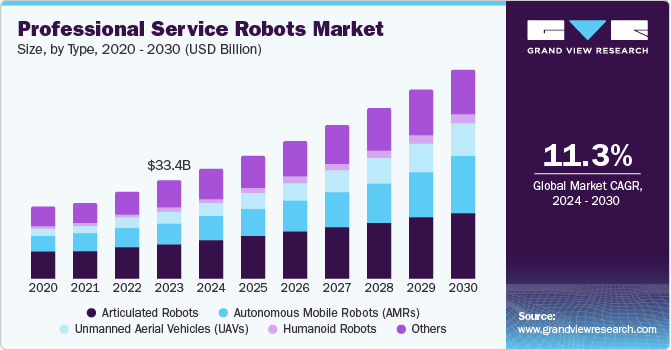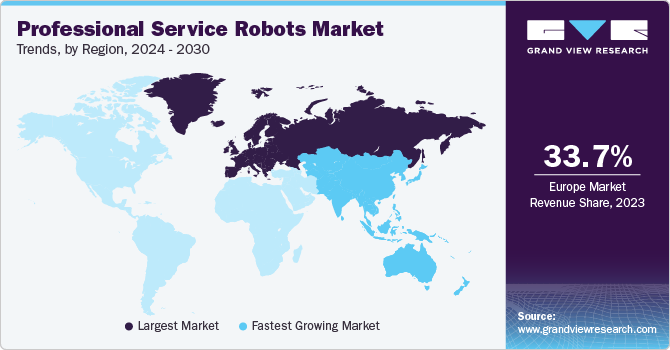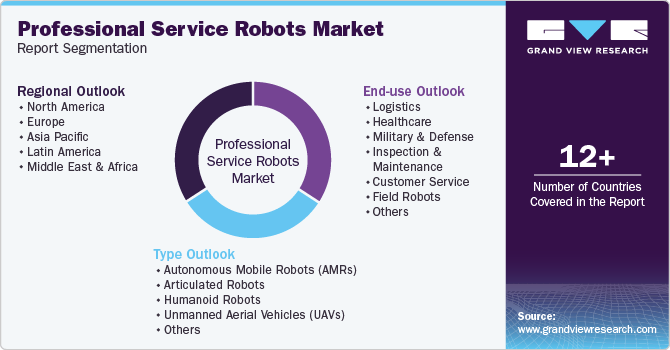
Professional Service Robots Market Size, Share & Trends Analysis Report By Type (Autonomous Mobile Robots, Articulated Robots, Humanoid Robots, UAVs), By End Use, By Region, And Segment Forecasts, 2025 - 2030
- Report ID: GVR-4-68038-441-3
- Number of Report Pages: 150
- Format: PDF
- Historical Range: 2018 - 2023
- Forecast Period: 2025 - 2030
- Industry: Technology
Professional Service Robots Market Trends
The global professional service robots market size was estimated at USD 38,160.3 million in 2024 and is expected to grow at a CAGR of 12.7% from 2025 to 2030. The market growth is primarily driven by growing advancements in automation and robotics technologies. The growing adoption of professional services robots across various industries, such as healthcare, logistics, and retail, is enhancing operational efficiency, reducing labor costs, and improving service delivery. Additionally, the increasing integration of remote operations, monitoring capabilities, and adaptability to regulatory changes is further supporting the widespread adoption of the professional service robots industry.

The increasing demand for automation in non-manufacturing sectors is further fueling the professional service robots industry growth. Companies are adopting robots to handle repetitive tasks such as data analysis, customer service, and package delivery, which helps improve productivity and allows human workers to focus on more strategic and value-driven activities. As automation technologies become more affordable and accessible, small and medium-sized enterprises (SMEs) are also integrating robots into their operations, which is expected to further drive the industry expansion.
Additionally, the logistics industry plays a crucial role in driving the adoption of professional service robots industry solutions, as there is a growing demand for automation in key operations such as loading, unloading, inventory management, and warehouse management. The increasing complexity of supply chains, combined with the need for greater speed and accuracy in operations, has led companies to turn to robotics for enhanced efficiency and reduced human error. Robots are being used to automate repetitive tasks such as sorting packages, moving goods within warehouses, and assisting with last-mile delivery.
Furthermore, recent advancements in sensor technologies are significantly enhancing the precision and functionality of robots across various industries. High-resolution cameras, LiDAR systems, and advanced tactile sensors are enabling robots to perceive their environments with unprecedented accuracy. For instance, in manufacturing, robots equipped with these sensors can detect minute defects in products, ensuring higher quality control. Similarly, in healthcare, surgical robots with improved sensory capabilities can perform delicate procedures with greater precision, reducing risks and improving patient outcomes. Such advancements and innovations are expected to drive the professional service robots industry demand.
The integration of artificial intelligence (AI) and machine learning into logistics automation is further enhancing its capabilities. Predictive analytics algorithms are being used to forecast demand, optimize inventory levels, and plan efficient delivery routes. Additionally, AI-powered systems can dynamically adjust warehouse operations in real time, such as rerouting robots during peak periods or identifying bottlenecks. These advancements are enabling companies to operate with greater agility and responsiveness, which is essential in the fast-paced e-commerce landscape. As a result, businesses that invest in logistics automation are gaining a competitive edge in terms of speed, accuracy, and cost-effectiveness.
Type Insights
The autonomous mobile robots (AMR) segment dominated the market with a share of over 37% in 2024, driven by labor shortages, high operational costs, and the need for efficiency. With the rise of e-commerce, AMRs are increasingly being deployed in warehouses to automate material handling and order fulfillment. Key trends driving segmental growth include the integration of AI and IoT technologies to enhance real-time data processing, autonomous decision-making, and navigation. Additionally, collaborative robotics is on the rise, allowing AMRs to work together to streamline operations and increase productivity, thereby driving the segmental growth.
The unmanned aerial vehicles (UAVs) segment is expected to witness a significant CAGR of over 13% from 2025 to 2030, owing to technological advancements in battery life, AI, and sensor capabilities, enabling them to perform a broader range of tasks. These developments, alongside regulatory support from governments allowing UAVs to integrate safely into national airspace, are pushing the market forward. Key trends driving segmental growth include the increasing use of AI and machine learning for autonomous navigation, obstacle detection, and real-time data analysis. UAVs are also finding new applications across various industries, such as agriculture, logistics, and infrastructure inspection, enhancing operational efficiency.
End Use Insights
The healthcare & medical segment accounted for the largest market share in 2024, driven by the need for improved patient care, precision, and operational efficiency. Rising healthcare demands, coupled with labor shortages and an aging population, are driving the need for automation in surgeries, diagnostics, and rehabilitation. Robotics is increasingly used in minimally invasive surgeries, robotic-assisted prosthetics, and rehabilitation robots, providing faster recovery times and better outcomes. Additionally, wearable and assistive robots are being deployed to support elderly and disabled patients, transforming healthcare delivery. These factors are driving segmental growth.

The logistics & transportation segment is expected to witness a significant CAGR from 2025 to 2030, owing to the rising demand for efficiency, speed, and cost reduction in supply chain management. The growth of e-commerce and the need for faster, more reliable deliveries are driving the adoption of automation in warehouses, sorting facilities, and transportation hubs. Robotics is streamlining processes such as order picking, sorting, and packaging. Key trends driving segmental grow include the use of AMRs in warehouses for material handling, AI-powered drones for last-mile delivery, and automated guided vehicles (AGVs) for transportation logistics. These innovations are improving operational productivity and reducing human labor requirements.
Regional Insights
North America is expected to grow at a CAGR of over 11% from 2025 to 2030, driven by substantial investments in robotics research and development, robust technological infrastructure, and a strong emphasis on innovation. The U.S. and Canada deploy service robots for surgery assistance, patient monitoring, warehouse operations, and surveillance, driven by government support, technological infrastructure, and private sector investments.
U.S. Professional Service Robots Market Trends
The U.S. professional service robots industry is expected to grow at the fastest CAGR of over 11% from 2025 to 2030, owing to high demand for automation in healthcare, logistics, and retail. The U.S. government is actively supporting the development and deployment of service robots through funding and policy initiatives aimed at advancing robotics research and development. This support is fostering innovation and accelerating the adoption of robotics across various sectors, including healthcare, logistics, and defense.
Europe Professional Service Robots Market Trends
Europe professional service robots industry is expected to grow at a CAGR of over 12% from 2025 to 2030, driven by labor shortages, technological advancements, and an aging population. European countries are increasingly adopting service robots in sectors such as healthcare, logistics, and hospitality. The European Union's focus on digital transformation and smart manufacturing is further accelerating this trend.
The UK professional service robots market is expected to grow at a significant rate in the coming years. The National Health Service (NHS) and private healthcare providers are deploying robots for tasks such as patient monitoring, medication delivery, and assistance in surgeries. The UK's emphasis on innovation and technological advancement is fostering a conducive environment for the growth of robotics in professional services. However, challenges such as regulatory hurdles and the need for a skilled workforce remain areas of focus for the industry.
The professional service robots market in Germany is fueled by a strong emphasis on automation and efficiency, particularly in the manufacturing and healthcare sectors. The country's robust industrial base and technological expertise are facilitating the integration of service robots in various applications, including assembly lines and patient care.
Asia Pacific Professional Service Robots Market Trends
The Asia Pacific professional service robots industry accounted for the highest market share of 51% in 2024, owing to the rising need for automation and sophisticated robotics in major industries such as healthcare, logistics, retail, and education. The region is a center for the production and deployment of professional service robots, with Japan, South Korea, China, and Singapore taking the lead. As innovation and investment continue, the Asia Pacific market is set to expand even further in the coming years.

The Japan professional service robots market is gaining traction, primarily driven by the nation's rapidly aging population, which has led to a significant shortage of healthcare and caregiving professionals. This demographic shift has intensified the demand for robotic solutions capable of assisting with elderly care, such as AI-powered robots for patient monitoring, rehabilitation, and companionship.
The professional service robots market in China is rapidly expanding, driven by technological innovation and growing demand in industries like healthcare, logistics, retail, and agriculture. China is dominating the world market with heavy investments from the government and private enterprises.
Key Professional Service Robots Company Insights
Some of the key players operating in the market include ABB Ltd. and Boston Dynamics, Inc., among others
-
ABB Ltd. is a multinational electrical engineering corporation that specializes in electrification, automation, and robotics, providing innovative solutions to enhance efficiency and sustainability across various industries. The company leverages its extensive engineering expertise to offer advanced automation solutions and digital services, positioning itself to meet the growing demand for cost-effective and efficient engineering solutions amid increasing competition in the sector.
-
Boston Dynamics, Inc. is a global robotics company known for developing advanced robots and human simulation software. The company specializes in creating dynamic robots that move and navigate with animal-like agility by integrating principles of balance, dynamic control, and innovative mechanical design.
Blue Ocean Robotics and Diligent Robotics, Inc. are some of the emerging participants in the professional service robots market.
-
Blue Ocean Robotics is a prominent innovator in the development, production, and commercialization of professional service robots, with a strong focus on sectors like healthcare, hospitality, construction, and agriculture. Its diverse portfolio includes well-known brands such as UVD Robots, a mobile disinfection robot; Beam Robots, designed for telepresence, communication, social inclusion, and CO2 reduction; and PTR Robots, which supports safe patient handling and rehabilitation.
-
Diligent Robotics, Inc. is a U.S.-based company specializing in healthcare robotics, with its flagship product, Moxi, designed to assist hospital staff with logistical tasks. The company focuses on developing robots that streamline workflows in clinical environments, reducing the burden on healthcare professionals. Diligent Robotics operates primarily in the North American market.
Key Professional Service Robots Companies:
The following are the leading companies in the professional service robots market. These companies collectively hold the largest market share and dictate industry trends.
- ABB Ltd.
- Blue Ocean Robotics
- Boston Dynamics, Inc.
- Cyberdyne USA Inc.
- Daifuku Co., Ltd.
- Fanuc Corporation
- Gecko Robotics, Inc.
- Honda Motor Co., Ltd
- Intuitive Surgical, Inc.
- iRobot Corporation
- KUKA AG
- SoftBank Robotics Group
- Diligent Robotics, Inc.
- Harvest CROO Robotics LLC
Recent Developments
-
In February 2025, Boston Dynamics partnered with the Robotics & AI Institute to advance humanoid robots through reinforcement learning. This collaboration focuses on developing dynamic and generalizable mobile manipulation behaviors for the new electric Atlas robot.
-
In January 2025, ABB Ltd. Robotics launched AppStudio, a no-code software tool designed to create customized robotic user interfaces. AppStudio simplifies automation and programming, especially for small and medium-sized enterprises, by enabling users of all experience levels to quickly create customized robot interfaces.
-
In December 2024, Honda Motor Co., Ltd introduced 'Haru,' an AI-powered social robot, at a hospital in Spain to support children undergoing long-term treatment. Haru is designed to enhance the well-being of young patients by providing companionship and interactive engagement during their hospital stay. This initiative reflects Honda's commitment to leveraging advanced technology for positive social impact.
Professional Service Robots Market Report Scope
|
Report Attribute |
Details |
|
Market size value in 2025 |
USD 43,522.9 million |
|
Revenue forecast in 2030 |
USD 79,171.6 million |
|
Growth rate |
CAGR of 12.7% from 2025 to 2030 |
|
Base year for estimation |
2024 |
|
Historical data |
2018 - 2023 |
|
Forecast period |
2025- 2030 |
|
Quantitative units |
Revenue in USD million/billion, and CAGR from 2025 to 2030 |
|
Report Product |
Revenue forecast, company ranking, competitive landscape, growth factors, and trends |
|
Segments covered |
Type, end use, region |
|
Country scope |
U.S.; Canada; Mexico; UK; Germany; France; China; Australia; Japan; India; South Korea; Brazil; South Africa; Saudi Arabia; UAE |
|
Key companies profiled |
ABB Ltd.; Blue Ocean Robotics; Boston Dynamics, Inc.; Cyberdyne USA Inc.; Daifuku Co., Ltd.; Fanuc Corporation; Gecko Robotics, Inc.; Honda Motor Co., Ltd.; Intuitive Surgical, Inc.; iRobot Corporation; KUKA AG; SoftBank Robotics Group; Diligent Robotics, Inc.; Harvest CROO Robotics LLC |
|
Customization scope |
Free report customization (equivalent to up to 8 analyst’s working days) with purchase. Addition or alteration to country, regional & segment scope. |
|
Pricing and purchase options |
Avail customized purchase options to meet you exact research needs. Explore purchase options |
Global Professional Service Robots Market Report Segmentation
This report forecasts revenue growth at global, regional, and country levels and provides an analysis of the latest technological trends in each of the sub-segments from 2018 to 2030. For this study, Grand View Research has segmented the professional service robots market report based on type, end use, and region:

-
Type Outlook (Revenue, USD Million, 2018 - 2030)
-
Autonomous Mobile Robots (AMRs)
-
Articulated Robots
-
Humanoid Robots
-
Unmanned Aerial Vehicles (UAVs)
-
Others
-
-
End Use Outlook (Revenue, USD Million, 2018 - 2030)
-
Healthcare & Medical
-
Logistics & Transportation
-
Warehousing
-
Last-Mile Delivery
-
Port and Cargo Operations
-
Others
-
-
Defense & Security
-
Hospitality
-
Inspection and Maintenance
-
Education
-
Retail
-
Agriculture
-
Others
-
-
Regional Outlook (Revenue, USD Million, 2018 - 2030)
-
North America
-
U.S.
-
Canada
-
Mexico
-
-
Europe
-
UK
-
Germany
-
France
-
-
Asia Pacific
-
China
-
Japan
-
India
-
South Korea
-
Australia
-
-
Latin America
-
Brazil
-
-
Middle East & Africa
-
Saudi Arabia
-
South Africa
-
UAE
-
-
Frequently Asked Questions About This Report
b. The global professional service robots market was estimated at USD 38,160.3 million in 2024 and is expected to reach USD 43,522.9 million in 2025.
b. The global professional service robots market is expected to grow at a compound annual growth rate of 12.7% from 2025 to 2030 to reach USD 79,171.6 million by 2030.
b. The autonomous mobile robots (AMR) segment dominated the market with a market share of over 37% in 2024, driven by labor shortages, high operational costs, and the need for efficiency.
b. Some of the key players in the global professional service robots market include ABB Ltd., Blue Ocean Robotics, Boston Dynamics, Inc., Cyberdyne USA Inc., Daifuku Co., Ltd., Fanuc Corporation, Gecko Robotics, Inc., Honda Motor Co., Ltd., Intuitive Surgical, Inc., iRobot Corporation, KUKA AG, SoftBank Robotics Group, Diligent Robotics, Inc., and Harvest CROO Robotics LLC.
b. Key factors that are driving the market growth include the growing adoption of professional services robots across various industries, and the increasing integration of remote operations, monitoring capabilities, and adaptability to regulatory changes.
We are committed towards customer satisfaction, and quality service.
"The quality of research they have done for us has been excellent."




